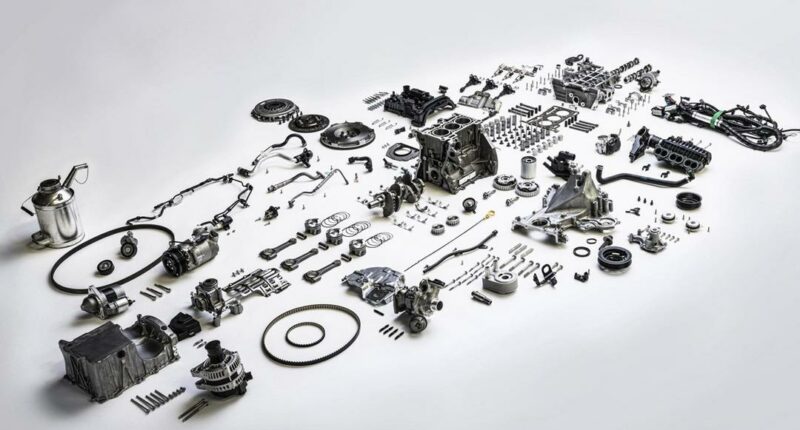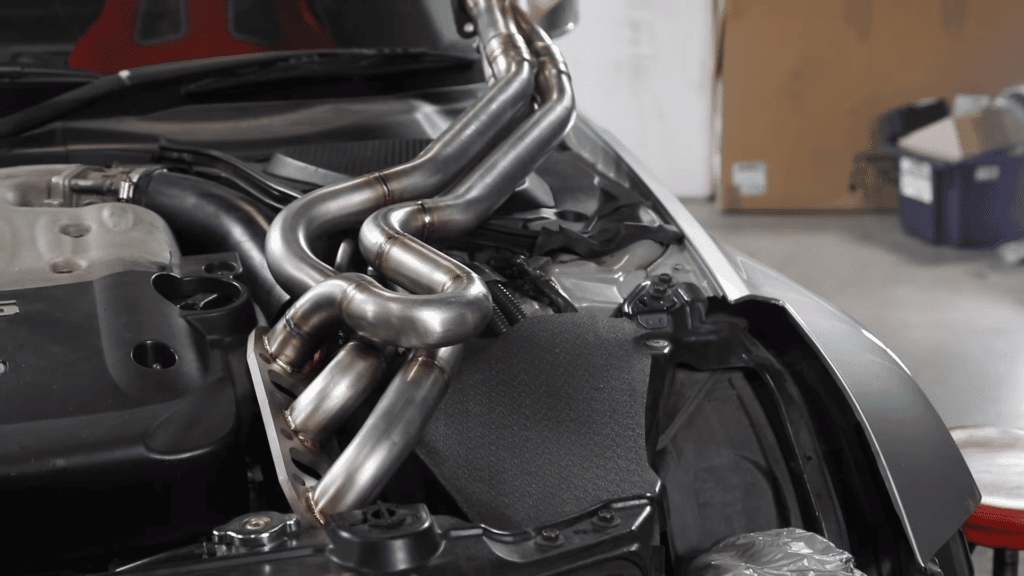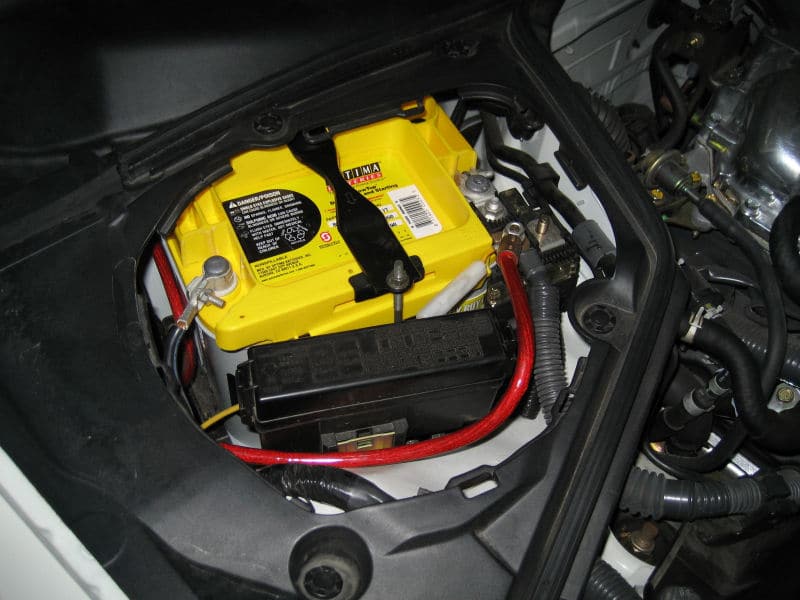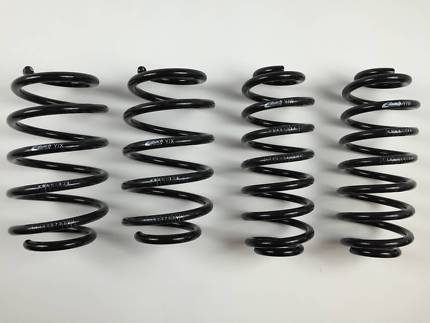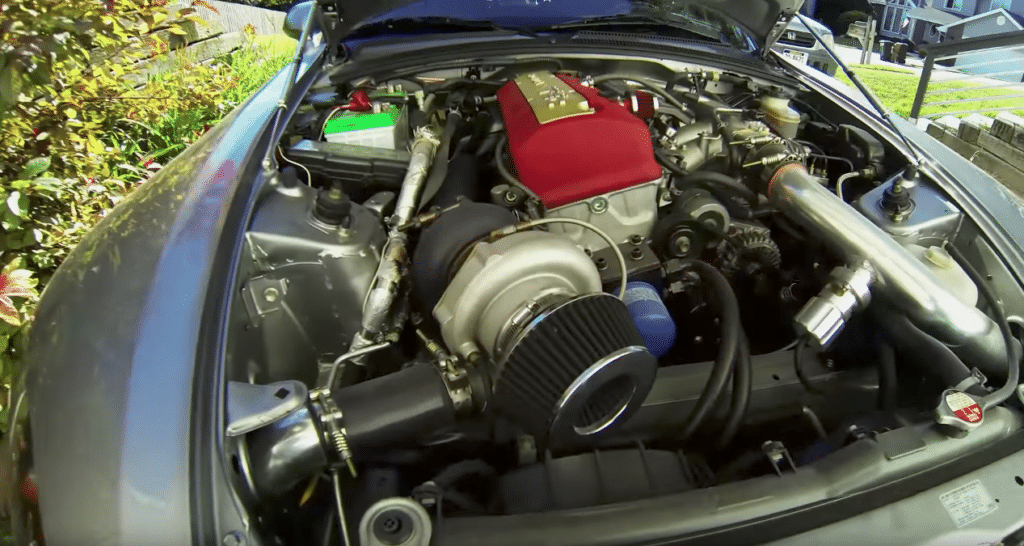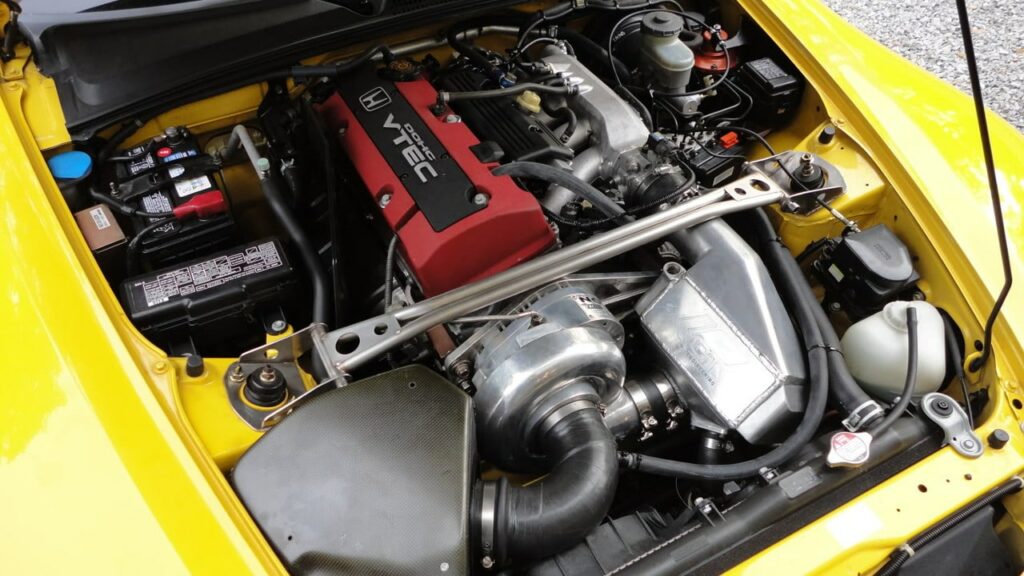There was a time when every car owner knew exactly how their vehicle worked, what parts it had, and how to fix it. Cars were simple back then — they had fewer computers, fewer sensors, and were easier to work with. Today, it’s a whole different story.
Whether you work on your own car or not, understanding its essential parts and being able to explain what’s wrong with them is a skill that’ll come in handy when you least expect it.
And besides, nobody wants to be that person who performs a reverse image search for their radiator and describes it as “a metal box with water in it”.
This is not an exhaustive car parts guide, in fact, it barely scratches the surface of what really goes on under your hood. Our top priority here is to give you a list of all car parts that are important to know about so that you can be an educated consumer.
Read on as we’ll dive deep into this car parts list (with pictures).
Engine Air Intake
Just like how humans require oxygen to function, engines also require it to keep running. Fuel cannot burn with oxygen which means your engine won’t even start without air, let alone run properly.
Every car has a set of components that draw air from the atmosphere, and send it straight to the engine. These components are collectively known as the intake system.
Signs of a failing intake system include:
- High or inconsistent idle
- Poor engine performance
- Check engine light
- High engine temperature
Let’s look into the major components of an intake system.
Air Filter
The deeper we dive into how human anatomy relates to machine anatomy, the more it fascinates us. Think of your car’s air filter as its lungs — its primary job is to make sure that the air it’s drawing in is clean and free of dust and debris.
It’s among the consumable parts that are replaced very often; simply look at your car’s service history and you’ll see how often your dealership must have billed you for an air filter replacement.
Not replacing your air filter in time causes problems like a clogged up air intake system, poor fuel economy, and poor performance.
Cold Air Intake
CAIs aren’t a common part found on many cars, it’s actually an aftermarket modification that is quite easily accessible to everyone. Some performance cars have this part installed from the factory while most don’t.
It’s essentially a set of piping with minimal bends, designed to relocate your air intake in a way that it can draw denser, oxygen-rich air from outside the engine bay.
Mass Airflow Sensor
The mass airflow sensor, abbreviated as MAF sensor, is what keeps the ECU informed about the quantity of air entering the engine.
The ECU relies on this information and modulates the fuel injection system in a way that it delivers the right amount of fuel to the engine. You must’ve heard stuff like “it’s running too rich/lean” — these words are used to describe the air-fuel ratio.
When your air-fuel ratio isn’t quite right, the culprit is almost always a failing MAF sensor. Some signs of MAF failure include:
- car won’t start
- stalling
- poor acceleration
- check engine light
If you’re experiencing these symptoms, before buying an expensive replacement it’s a good idea to buy a quality MAF sensor cleaner. A can of cleaner is a whole lot cheaper than a replacement unit, and 9 times out of 10 it will do the trick!
Throttle Body
We just learned that mass airflow sensors monitor the amount of air flowing into the engine and that air enters through the intake. But what regulates the quantity of air entering the engine? It’s the throttle body and your right foot — no surprises there.
Based on your input on the gas pedal, your throttle body (which uses a butterfly valve) opens and shuts to regulate the flow of air into your engine.
However, most throttle bodies today are electronically controlled.
Exhaust System
The exhaust cycle is just as crucial as the intake cycle; one cannot exist without the other. Every internal combustion engine produces waste gases which, if not released, cause all kinds of expensive damage.
This assembly starts with the exhaust manifold that’s connected directly to your engine and ends with the muffler — the part that’s visible from the rear end. All of the components mentioned here are designed to work together, known collectively as an “exhaust system”.
Exhaust Manifold
This is where the exhaust’s exit journey begins. After the combustion cycle in your engine is complete, the expelled exhaust gases are collected by your exhaust manifold which then delivers them to the rest of your exhaust pipe assembly.
Exhaust manifold leak is a common problem that plagues many old cars. If your mechanic mentions this issue, please do not ignore it, it can wreak havoc with your engine and cause the exhaust gases to flow the other way into your intake manifold!
O2 Sensor
The O2 sensor has one job — to monitor the oxygen levels in your exhaust gas and communicate the same to your ECU. This helps mechanics and tuners to determine whether your engine is running rich or lean.
Modern, non-carbureted cars, however, have very sophisticated fueling systems that rely on the O2 sensor’s data and alter the fueling to maintain efficiency.
This means that driving with a faulty O2 sensor won’t hurt the performance of your car but it will mess with your fuel economy and clog up the catalytic converter which is expensive to replace. So if you have a faulty O2 sensor, we recommend getting it replaced at the earliest.
Catalytic Converter
The combustion process in car engines is inherently inefficient; though it’s getting better by the day, but only slightly. In a perfect world, car exhaust gases would be 100% free of toxic fumes but we don’t live in a perfect world now, do we?
Catalytic converters are needed to reduce the toxicity of exhaust gases. It’s essentially a metallic enclosure with a ceramic plate that has layers of chemical compounds.
These chemicals help to convert toxic elements like carbon monoxide and nitrogen oxide into less harmful substances like carbon dioxide and water vapor. Long story short, cleaner emissions; that’s why it is mandated by law to have a catalytic converter in every car.
Tailpipe
The part of your exhaust system that’s visible and sticks out near the rear bumper is called the tailpipe. It’s the last set of piping in your exhaust system and its primary role is to direct the exhaust away from your vehicle.
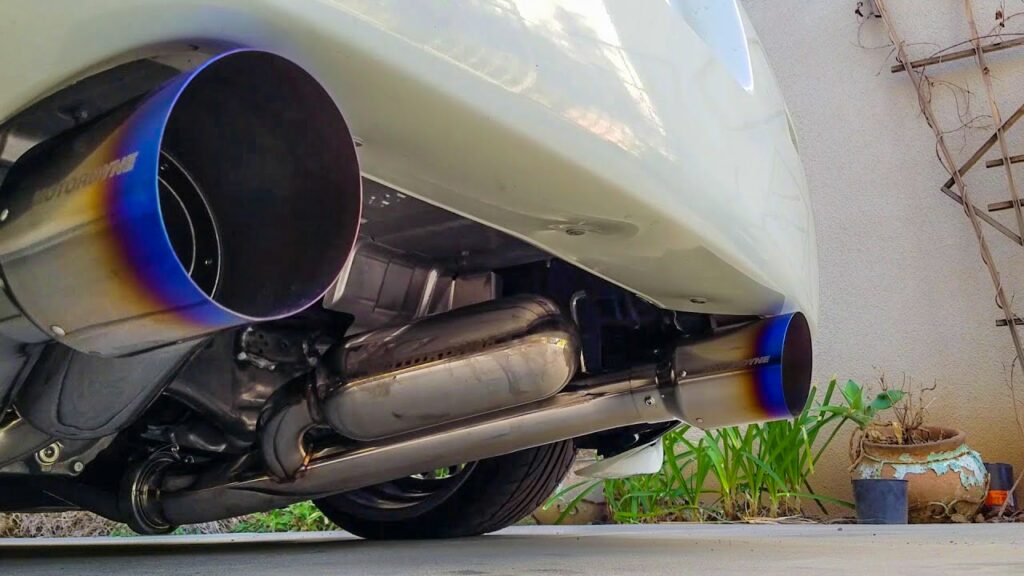
Cooling System
Heat is the single biggest enemy of efficiency and performance. Any technology that produces power also produces heat and so it needs a proper cooling system in order to not burn itself out. This includes everything from the processor in your laptop to the engine in your car.
The automotive cooling system includes critical components…
Radiator
Your radiator is the MVP of your car’s cooling system and it does most of the thermal heavy lifting. It doesn’t cool your engine as directly as you might think; it’s the coolant that does that. Here’s what happens; coolant gets circulated throughout your engine, absorbing heat all along the way. Then it enters your radiator where it cools down and then goes back into the engine.
By drawing cool air from outside the engine bay, your radiator is able to bring the boiling coolant back to normal temperature. This continuous process is what ultimately keeps your engine cool. Without a radiator, your engine will overheat in no time.
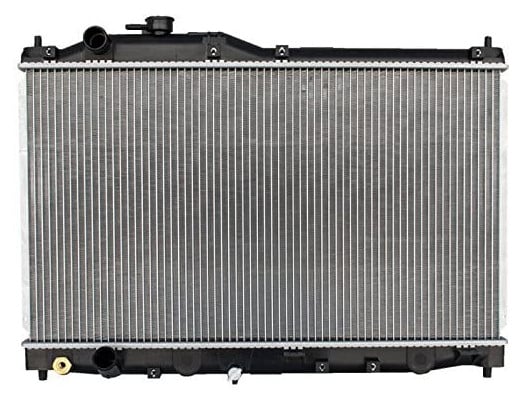
Radiator Cooling Fans
Most machines are engineered to make use of natural energy; cars are a great example. Every car is designed to use the natural airflow it receives while being driven. Your intake system relies on this airflow to keep the engine running and your radiator does the same to keep the engine cool.
But have you wondered what happens when the car is at a stoplight? How does the radiator keep it cool when there’s no natural airflow? Here’s where cooling fans come into the picture. These electric fans are mounted at the back of your radiator, on the side that’s closest to the engine. They keep the airflow going even when the vehicle is not moving.
Coolant Expansion Tank
Coolant expands when it heats up — just like every other liquid on the planet. Do a little thinking and you’ll instantly see why this can be problematic in your sealed cooling system.
When coolant expands in the limited space it has, it creates pressure that must be released. To do this, a pressure cap is used. It’s a simple device that is designed to maintain pressure within the sealed system.
However, the excess coolant doesn’t get disposed of, instead, it is stored in a separate reservoir so that it can be reused when the coolant contracts back to its original size as a result of the engine cooling down.
Water Pump
The primary role of the water pump is to keep your coolant well circulated throughout the cooling system. The word “water” doesn’t have anything to do with its functionality, it can also be referred to as a coolant pump.
Thermostat
Picture the thermostat as a bouncer at an exclusive nightclub with a strict door policy and the coolant is some dude who’s waiting to get in; the nightclub in this scenario is the radiator.
The thermostat is a temperature sensor / fluid blocker combined in one device. It senses the coolant’s temperature and prevents it from flowing into the radiator unless it’s hot enough.
It does this to make sure that the engine quickly gets to its optimal operating temperature. This bypass system also prevents hot spots and balances the temperature throughout the engine to protect it from knocking-related damage.
Because the engine warms up sooner, it also allows the heater to make the interior cabin nice and toasty even on cold, winter mornings.
Electricals
Mechanical auto parts are quite simple to understand, but the electrical system is a completely different animal — even some of the most well informed automotive enthusiasts leave this to the professionals.
Because the electrical system is not as hot a topic as something like forced induction or aerodynamics, it’s hardly talked about. It’s astounding how well designed this technology is.
Here’s an example of how amazing this everyday technology actually is:
Your engine and chassis are actually a part of your car’s electrical circuit; they’re used as ground terminals. The usual arrangement involves the negative side of the battery being grounded to the engine and the engine grounds to the chassis.
Along the entire electrical circuit, all components that require current are connected to either the engine or the chassis. The reason behind this is to give every electrical component a path back to the negative terminal of the battery without needing an additional wire.
If cars didn’t do this, we’d have twice the amount of wires to deal with which means twice the amount of possible electrical failures. Not to mention the added weight — wires are heavy. Whenever someone says “grounded to chassis” or “grounded to frame”, this is what they’re talking about.
Without an electrical system, cars will lack the basic comforts that most of us take for granted today. These include lights, air conditioning, wipers, ECU, ABS, airbags, and even the electrical starter! Imagine having to hand-crank your engine every morning!
To get a basic grasp of what the electrical system does in your car, you need to know it’s main components. These include:
Battery
The battery is the heart of the electrical system — it’s where the electrical current in your car begins and ends. Without it, nothing would work; not even your starter.
It does the fundamental job of storing and providing electrical current to most of the components in your car.
Alternator
While the battery stores electricity, the alternator produces it and uses the same to keep the battery from running out of juice. Do note that it is not a dedicated battery charger; if you have a dead battery, driving around the block a few times won’t charge it. It’s going to need to be charged separately.
The main reason for this is that the alternator relies on the engine’s mechanical power for producing electricity. The harder you make it work, the more power you’ll be robbing off your engine.
Cables and Connectors
Cables and end connectors are perhaps the most understated electrical component among modern cars. They serve the purpose of delivering the electrical current from the battery to every component that needs it.
The quality of your cables can make or break your electrical system. In fact, most electrical problems originate from faulty cable or grounding. That said, if something electrical isn’t working right in your car, get the cables checked before spending a bunch of cash on replacement components.
ECU
ECU stands for Electronic Control Unit; a term you’ve definitely heard being thrown around in the world of automotive repair. Your ECU is your car’s brain, it makes your car smarter and more efficient.
Depending on how modern your car is, your ECU can control many of its components and this is done based on data collected by numerous sensors located throughout your vehicle.
The O2 sensor is a good example.
From an electrical standpoint, with most modern cars, Voltage is also regulated by the ECU in order to optimize the flow of electricity throughout the system, without putting too much load on the engine.
Starter Motor
The starter motor is what gets the ball rolling by starting your engine. It’s connected to the battery and the ignition switch which can be operated with a key or a button.
Most of the power draw comes from the starter motor; understandably, it needs a power to get your car started. The radio, headlights, and even air conditioning, none of it comes close to the power demands of the starter motor. It is the single biggest user of electricity.
To understand how it works and why it needs so much power, you need to know about the basic 4-stroke cycle of the internal combustion engine. Here’s how it goes:
- Intake: Air and fuel is drawn into the cylinders
- Compression: Air/fuel mixture is compressed by the piston as it moves up
- Combustion: The spark plug ignites the air/fuel mixture
- Exhaust: Leftover gases are expelled after combustion
The timing of all these functions is set according to the position of the pistons — meaning, air intake will only occur while the pistons are on their way down, and spark will only occur when the pistons are on the very top of the cylinder. The ECU knows this very well.
This is why an engine can only be started with additional help — if something rotates it. That’s the job of the starter motor. The engine could have stopped at any point with its pistons at any position. For it to start again, it needs to get back around to a power stroke, and that’s where the starter motor helps.
It rotates the flywheel which then rotates the crankshaft of the engine. That’s why it needs so much power. It’s designed for bursts of high power and not endurance. Examples: Push starting your car and pulling the cord on your lawnmower.
Due to how hard these car parts work, most cars will need a replacement starter motor every decade or so.
Spark Plug
This tiny little part has a massive impact on how your engine performs. It holds the responsibility of igniting the air/fuel mixture within your engine, at the right time.
It’s timing and firing pattern is controlled by the ECU. That’s not all; spark plugs also play the role of a heat exchanger by pulling away heat from the combustion chamber for better efficiency.
Fuel System
In order to function, every internal combustion engine has 3 basic needs: air, electricity (ignition), and fuel. We discussed the first two, now let’s explore what makes the fuel system in your car work.
The fueling system stores and supplies fuel to your engine. One important thing we must know is that fuel system components differ from car to car. This majorly depends on:
- Whether your car runs on gasoline or diesel
- Whether your car uses a carburetor or electrical fuel injection
Carburetors are long gone; electric fuel injection is the norm in today’s modern cars. That said, your car most certainly has a fuel-injected gasoline/diesel motor. The most critical fuel system components include:
Fuel Tank
Even though the fuel tank has one simple purpose — storing fuel — knowing about it helps you to make important decisions like:
- Calculating how long you can go on a full tank of gas before requiring a refill; something you should know before heading out on a road trip.
- Benchmarking the weight of your car + fuel + passengers before heading out for a bank heist.
Fun facts:
- Kerb weight = Your car’s weight on a full tank of gas + all other liquids (engine oil, coolant, etc.)
- Dry Weight = Your car’s weight without any liquids at all.
Fuel Pump
The fuel pump in your car transfers fuel from the tank to the engine, either mechanically or electrically. Modern cars have an electric fuel pump installed inside the fuel tank.
If you’ve ever had to replace a fuel pump, you’d know that it is an expensive job. You’d also know that this happens when you let your car run low on fuel too often; an easily avoidable mistake.
When you let your car run low on fuel and circumstances don’t present you with a gas station when you need it the most, it hurts both, your fuel pump and your ego. Neither of these are easy to fix.
Fuel pumps hate running dry, especially if you drive a car that runs on diesel — a thicker fuel that requires a complex pump and injectors. With this considered, be sure to keep your tank filled regularly, or your wallet will have to be emptied at the repair shop.
Fuel Filter
In every car, fuel has to travel through many small and large passages. Most notability, fuel injectors have really tiny openings that can sometimes get clogged.
A good fuel filter is necessary to prevent this from happening; it does for fuel exactly what air filters do for air.
Fuel Injector
As the name suggests, fuel injectors deliver the final spray of fuel into your engine during the intake cycle.
Unlike carburetors that are 100% mechanical, fuel injectors are electrically controlled by the ECU. They’re more efficient, deliver better power, and give us complete control over the fuel-air ratio. This is why the whole auto industry decided to cut carbs.
The fuel injection system is very precise. Each spray contains a fixed amount of fuel that’s regulated and timed by the ECU to work cohesively with the spark plug. Pretty neat.
Engine
Of all the components in a car, it’s the engine that always grabs the spotlight for good reason — it’s what makes the most important things happen. The power, the sound, the momentum, is all because of the engine.
Knowing the components in your engine will help you compare cars from a practical viewpoint. You’ll be able to form your own opinions as to which engine suits your needs and this will help you to make better purchase decisions.
The most important engine components include:
Cylinder
The space in which the pistons in an engine travel is called a cylinder. If you’ve heard of 3-cylinder and 4-cylinder (4 banger) engines — this is what it means.
4-cylinder engines have 4 separate cylinders, each complete with a piston, and it’s own set of spark plugs, intake/exhaust valves and fuel injectors in some cases.
The capacity of an engine is measured according to the volume of air/fuel mixture that each cylinder can hold. This is denoted as CC (cubic centimeters) or L (liters). A 2-liter engine is the same as 2000cc.
Piston
A piston is a cylindrical block that moves up and down within a cylinder. This is something you’ve definitely seen in car commercials or 3D-animation videos.
Pistons play an integral part in the engine as they are the driving force behind the four-stage power generation process (intake, compression, combustion, exhaust). The pistons are connected to the crankshaft which rotates because of the four-stage cycle.
Crankshaft
The crankshaft is the “giver” — it supplies power to a number of different components. Some of these can include:
- Supercharger Impeller
- Hydraulic Power Steering Pump
- Flywheel
- Alternator and more.
This list differs from car to car. The main job of the crankshaft is to convert the pistons’ power into rotational motion which is sent to the flywheel and then to the entire drivetrain. Newer cars are controlled by a crankshaft position sensor, to fine-tune timing on the go.
Camshaft
The camshaft is an old yet faithful engine component that has been serving the IC motor well ever since it was first pioneered. Its job is complex, vital, and very interesting!
It’s basically a rod that runs parallel to the crankshaft, connected via a timing belt. Along its length, it has egg-shaped lobes that rotate in order to open and close the intake/exhaust valves.
The challenge here is that it has to be synchronized with the ignition cycle (spark) for the engine to function correctly. Newer cars use a crankshaft position sensor to perfectly synchronize this movement.
Connecting Rods
Connecting rods are the strongest component in the engine as they connect the piston head to the crankshaft. These rods have to spend the vehicle’s entire time doing some real heavy lifting and so they’re built to last.
Valves
Engine valves let air in and out of the cylinder; they’re the backbone of the intake and exhaust process. These valves are opened and closed by the camshaft.
Drivetrain
So you’ve understood how your engine makes power, that’s great. But have you ever wondered how that power makes its way to your tires?
The drivetrain is a complex and fascinating set of components that help to convert the engine’s power into actual movement.
Below we’ll dig into some of the main components that make up the automotive drivetrain system.
Flywheel
The flywheel is the main connection point between the engine and the rest of the drivetrain. It’s a weighted wheel that rotates alongside the engine. Because it is so heavy, it does a fantastic job at storing energy. This means that even if you stop accelerating, the weight of the flywheel will continue the circular motion.
For example:
When you’re riding a bicycle uphill at a lower gear, you’ll observe that the bike only moves ahead when you pedal. If it had a flywheel, it would’ve stored the momentum and riding uphill would’ve been easier.
Clutch/Torque Converter
Manual transmission cars have a clutch while automatic transmission cars use a torque converter instead. The purpose of both these parts is to transmit power from the flywheel to the transmission; flexplate if it’s an automatic.
In a manual transmission car, in order to shift gears and come to a halt without stalling, something has to break the connection between the engine and the driveshaft. This is exactly what the clutch does; if your manual car didn’t have a clutch, your engine would stall at every stoplight.
Automatic cars, however, don’t require a clutch — that’s the whole point of auto transmission. Unlike a manual clutch that uses pressure plates to generate friction, a torque converter employs a mechanism where it uses something called liquid-coupling to transfer power between the engine and the driveshaft.
Transmission
The main function of a transmission, whether automatic or manual, is to transfer power to the driveshaft and to set the wheels in motion. It has to make sure that the speed and the torque of the driven wheels are in sync with the engine speed.
Suspension
The words “suspension” and “shock absorber” are often used interchangeably. This is correct to some degree but not quite; “shock absorbers”, so to speak, are a part of every car’s suspension system.
It is called “suspension” because it refers to the entire assembly of components (including springs) used to suspend a car’s chassis, engine, and drivetrain above the wheels.
Everything that is suspended above the wheels is considered as “sprung mass” and whatever’s beneath that is called “unsprung mass”. At face value, what suspension does might seem pretty straightforward but there’s a lot of “behind the scenes” engineering wizardry that goes on down there.
We could make this entire article about suspension systems and it would still be just the tip of the iceberg. For the sake of simplicity, we’ll go over the most basic suspension components you should know about.
Springs
This one’s a no-brainer; springs help to absorb the impact from bumps and road undulations. However, they cannot function properly unless they’re paired with a damper.
One important thing you should know; sports cars designed for high-speed handling have a very stiff suspension setup — it’s meant to be that way. In case you happen to test drive a car like that and find the comfort level low, this is why.
Cars designed for daily driving are usually loosely sprung so that they can swallow bumps for a smooth ride but they’re prone to body roll, dive and squat.
Dampers/Shock Absorbers
Springs alone cannot absorb an impact and/or give you a smooth ride. For example, without a damper, your car will keep bouncing even after you’ve crossed a speed bump, making the handling very sketchy.
Dampers help to dissipate the energy absorbed by the springs — they slow down the springs’ movement and that’s what stabilizes your car.
Strut
The strut is a common dampening structure that does the same thing as a shock absorber and then some. It provides structural support to the car’s suspension system.
It’s basically a shock absorber mounted within a coil spring as one unit. McPherson Strut is a really popular strut assembly type used in cars all over the world. There’s a good chance that your car has one of these.
Control Arms
Control arms hold the entire suspension assembly together with the help of ball joints and bushings. They’re a critical link between the chassis, wheels, and other suspension components.
Fast-paced suspension system advancements in the auto industry is the reason why control arms are available in a massive variety of shapes and sizes. They help modified car owners to be able to adjust their suspension geometries such as steering lock and camber angles further than is available with OEM parts.
Steering
Out of all the controls needed to operate a car, steering is the most important function to master and the most immersive of them all.
Before we get into steering components, it’s important for you to know the 3 main types of steering systems that are being used in commercial cars today.
Both hydraulic and electric power steering share the same rack and pinion style system but use different components to assist with the steering input.
Here’s what rack and pinion based steering systems have in common.
Steering Column
This part includes everything that connects your steering wheel through the firewall, into the engine compartment, and finally to the rack and pinion mechanism.
Pinion Gear
This little guy makes the real magic happen. The pinion gear is located at the end of the steering column and connected to the steering rack. It helps to convert the steering wheel’s circular motion into linear (side to side) motion which in turn enables the tie rods to turn the wheels.
Tie Rods
Tie rods, coupled with ball joints, are connected to each end of the steering rack. They’re the final link between the entire steering assembly and the tires.
Steering Rack
The steering rack is a flat toothed bar that works together with the pinion gear to make your wheels turn. It is enclosed in a transfer tube that has the tie rods protruding at both ends.
Hydraulic Power Steering
Hydraulic assisted steering or HPS employs an engine-driven hydraulic pump to amplify the driver’s steering input. This is done by assisting the load being applied to the steering rack so that the effort required to turn the wheel is far less compared to a fully manual steering system.
Here are the components that are exclusive to cars that have HPS.
Fluid Cooler
The fluid cooler helps to prevent the power steering fluid from overheating and causing damage to other parts of the hydraulic system. It is connected via multiple hoses that need to be bled and maintained regularly.
Power Steering Pump
The steering pump circulates pressurized fluid, enabling the hydraulic system within the rack to assist the steering input just like an electric motor would.
Electric Power Steering
Electric steering, also known as EPS, uses an electrically powered motor mounted directly to the steering rack. This motor assists and controls the driver’s steering input.
Unlike HPS which requires engine power, EPS doesn’t rob any power off of the crankshaft and relies solely on the electric motor which feeds off the battery and the alternator.
Components exclusive to EPS include:
Electric Motor
The electric motor drives a gear that’s either connected to the steering column, or to the steering rack and its main purpose is to supply assistive torque to turn the wheels.
Torque Sensor
This unit is bolted on close to the pinion gear where it measures the torque or force being exerted on the steering wheel by the driver. The information it collects is then fed into the steering system’s control unit.
Drive-By-Wire
This is a fairly new steering concept which will be critical for the development of autonomous driving cars. Even though we’re fans of HPS and well-designed EPS (rare to find), the drive by wire technology is too interesting to leave out from this list of auto parts.
It will certainly take a few more years for this tech to excel in the tactile feedback and road feel department. With well-executed programming strategies, we’re sure it’ll get there.
Here’s how it works:
This system completely eliminates the steering shaft and instead uses cables and actuators that transmit electrical signals from the steering wheel to the tires.
Unlike HPS and EPS, there is no mechanical contact between the two main controls. Well, technically there is; a backup mechanical link is used in case the system fails.
Components include:
Steering Force Actuator
Just like what the torque sensor does on EPS systems, the steering force actuator receives steering input from the driver and sends it to the ECU.
Steering Angle Actuator
The steering angle actuator is responsible for moving the tires and transmitting important feedback data back to the steering force actuator so that it can give the driver a real-ish feel of the road.
ECU
Literally every action in a drive-by-wire system is controlled by the ECU through complex calculations performed based on the data it collects.
Forced Induction
If you’ve made it this far into our list of car parts, you know that engines require an inflow of air to make power. The math is simple, more air = more power.
What if there was a way for engines to draw even more air than what the intake system is capable of? There is a way, it’s called forced induction.
Turbocharging and Supercharging are the two most popular and commercially used forced induction systems in automobiles. Cars that do not utilize forced induction to get more power out of the engine are called naturally aspirated cars.
Turbocharger
Both superchargers and turbochargers are air compressors that are used to increase the pressure of air entering your engine. The key difference lies in how they draw that extra air.
Turbochargers rely on the engine’s exhaust stream to spool up a turbine which pushes air into the engine. Quite efficient!
Turbine
The most vital role in a turbocharger is that of the turbine; it’s responsible for converting exhaust pressure into rotational force which is used to spin the compressor.
Compressor
The compressor does exactly what it says — it compresses fresh air. The rotational force from the turbine makes the compressor spin fast enough to pull and compress air from outside the engine bay.
The faster you drive, the more air the compressor receives, except, it’s not just drawing air as the intake does, it’s also compressing it. This compression creates air pressure in the throttle body which is released in the form of a turbo boost.
Supercharger
Unlike turbochargers that rely on the exhaust stream, superchargers use a belt-driven impeller that spins by drawing power straight off the engine’s crankshaft. Mechanically, both forced induction systems do similar things but the way they do it is different.
Intercooler
Intercoolers are used on turbos as well as superchargers because both systems generate tremendous amounts of heat — enough to fry nearby components and enough to harm performance.
Needless today, a separate cooling system is required. The intercooler functions just like a radiator but it’s exclusively reserved for the forced induction system.
Impeller
The impeller does something similar to what the compressor does in a turbocharger. It is connected to a pulley that’s driven by the engine. When the pulley spins, it spins the impeller along with it.
When the impeller spins, it draws air just like the intake does. It then compresses the air and sends it straight to the intake manifold or routes it through the intercooler, depending on the setup.
Interior
There isn’t much to interiors; because each car is different, we’re only going to list the most useful components/features.
Shift Lever
The shift lever goes by many names; gear shift, gear stick, shifter, and gear lever. Call it whatever you like, it still does the same thing — it lets you switch between gears.
The way you treat your manual shift lever can affect the health of your overall transmission system. There are things you should never do with manual transmission cars; number one on both these lists is to not use the shift lever as a hand rest.
An affordable and popular modification for many car owners is to add a short shifter. This shortens the throws between gears and makes your car feel much sportier.
Infotainment System
From audio systems and touch-screen displays to Bluetooth connectivity and navigation, we’ve come a long way in technology and the features of in-car entertainment systems are only growing. All of this can be easily accessed through the central touchscreen between the two-front seats.
However, we urge you to not operate the infotainment system while driving. The best way to do this is by preloading your maps, sending your calls to voicemail, and/or selecting your playlist in advance!
Odometer and Trip Meter
The odometer shows your car’s overall mileage from the day it was purchased. The reading may or may not be accurate depending on whether your car is new or used.
People have always found a way to alter the odometer readings to get a better price on their cars — just something to have in mind before buying a used car.
A trip meter is different, it’s like a temporary odometer if you will. You can reset it before every commute and use it to calculate stuff like total distance traveled in a day, during a road trip, or to calculate your annual fuel consumption.
Tachometer
Sitting right beside the speedometer is the tachometer — it indicates your engine RPM. If there’s any dial on your dash that you should pay attention to, it’s this one.
Being aware of your tachometer readings makes it easier for you to know when to shift and to understand your car better.
Exterior
Let’s conclude this auto parts list with the simplest exterior components. Unless you drive an exotic car with active aero, most components on the exterior are going to be of purely aesthetic and structural value with no added performance.
Windshield Pillar
Notice the pillars that frame the windscreen on each side? These windshield pillars, also known as A-pillars, are responsible for holding the windscreen in place. And just like pillars do, they provide support and structure as well as connect the roof to the car’s body.
Windshield pillars get a bad rap because of the blind spots they cause, especially on the driver’s side. But till we find a better way to uphold a car’s structural integrity, these A-pillars are here to stay.
Roof Rail
Some cars come with factory fitted roof rails. For those that don’t, purchasing from the aftermarket is always an option.
Roof rails are extremely utilitarian; regardless of how they look — many automotive enthusiasts don’t like the aesthetic interference. However, with a tastefully selected roof box, the whole package can look pretty good.

Spoiler
Spoilers are a crowd favorite exterior component. Even though they don’t do anything functional for most cars, people love having them installed.
The idea behind spoilers is that when you’re at a high enough speed, the spoiler creates downforce and keeps your car glued to the road for better, safer handling.
Splitter
Splitters instantly make your car look sporty and aggressive; the best part about installing them is that you’ll get the aftermarket look without having to invest in an expensive body kit.
Car Parts List: You Made It!
If you read this far into our car parts list, chances are that you now know more about cars than most people — unless you’re already an automotive enthusiast reading just for entertainment.
This just goes to show that you don’t have to be a petrol head or an engineer to understand how your car works.
What’s your favorite car part from this list? What would you like us to cover next?
Tell us in the comments below!
